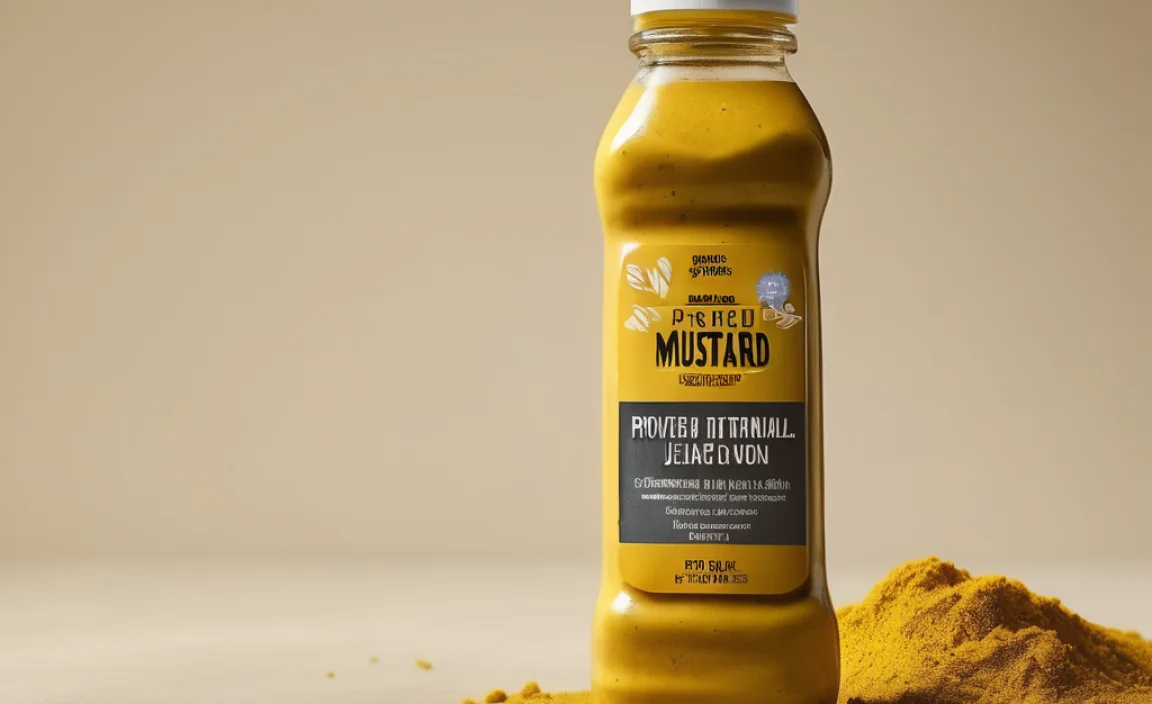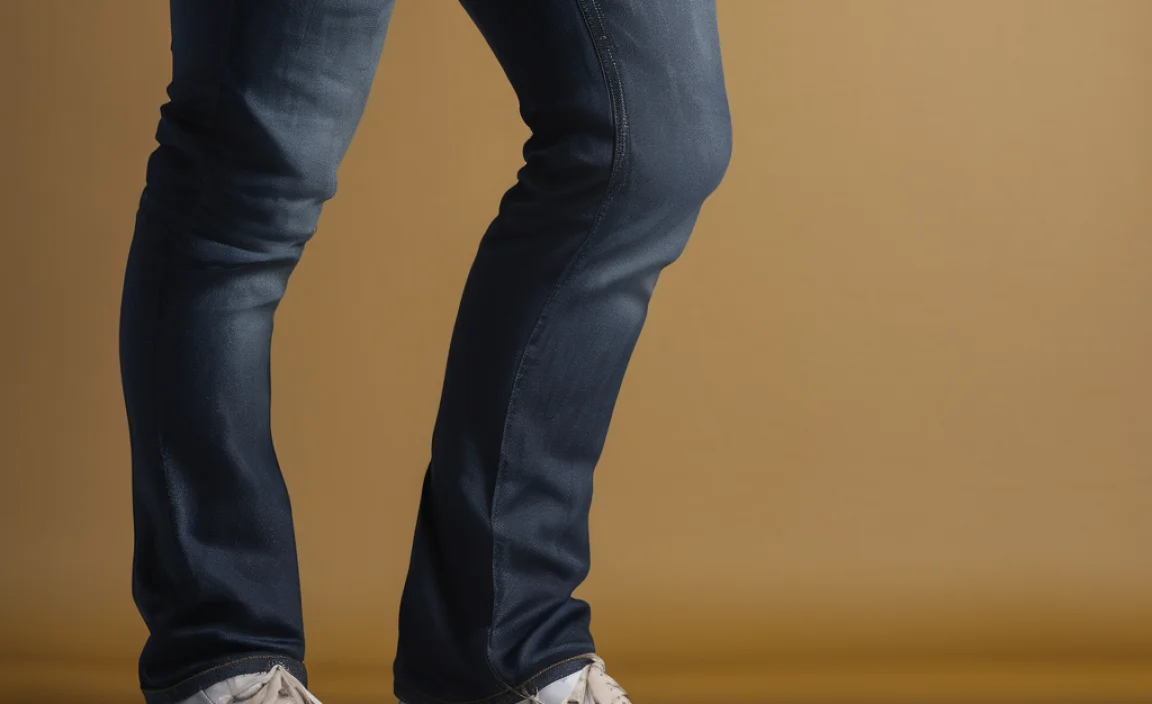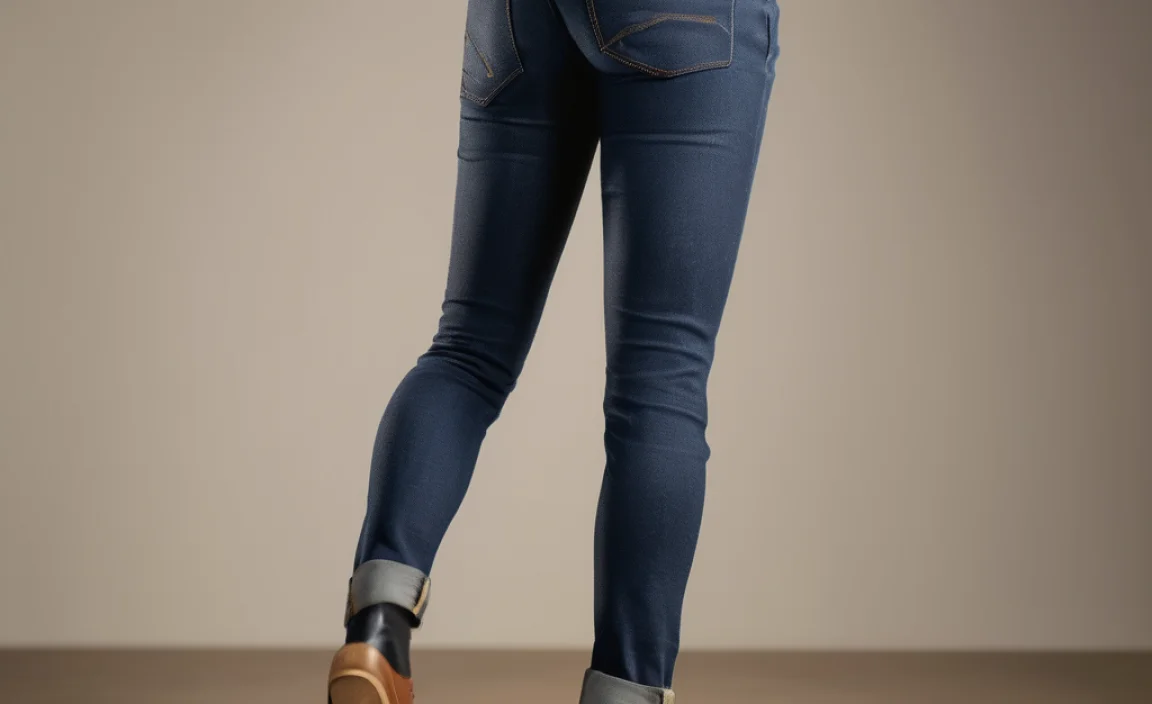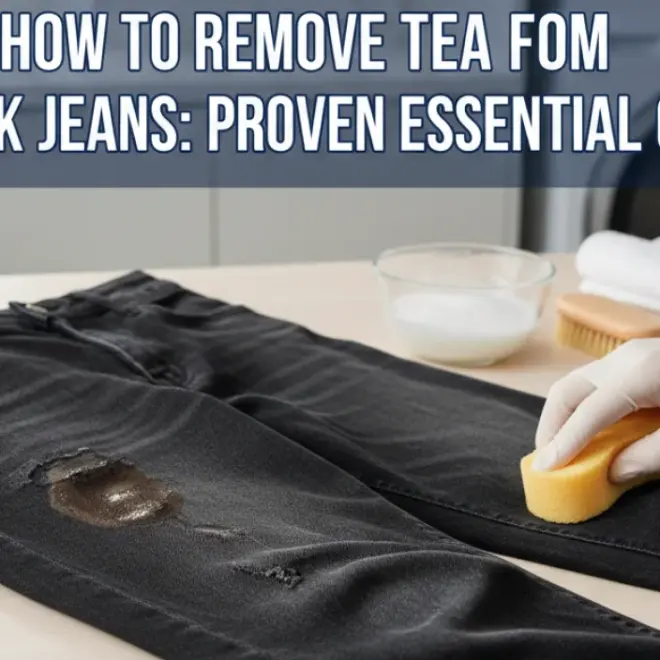Quick Summary: To remove mustard from dark wash jeans, act fast! Gently blot excess, then treat with a pre-wash stain remover or a DIY paste of baking soda and water. Rinse and wash as usual. Always test on an inconspicuous area first to ensure colorfastness.
How to Remove Mustard: A Proven Dark Wash Jeans Solution
Spilled mustard on your favorite dark wash jeans? Don’t panic! That vibrant yellow stain might seem stubborn, but with the right approach, you can often rescue your denim. This guide will walk you through simple, effective methods to tackle mustard stains, keeping your jeans looking their best. We’ll cover everything from immediate action to powerful cleaning techniques, ensuring you can confidently deal with this common laundry mishap.
Mustard stains are particularly tricky because of their turmeric content, the pigment that gives them their bright yellow hue. This pigment can bind to fabric fibers, making it difficult to remove if left untreated for too long. The good news is that dark wash denim, while dark, can still show these stains prominently. Fortunately, the methods to remove them are generally safe and effective if done promptly.
This article provides a step-by-step solution designed for beginners. You’ll learn what to do right away, which cleaning agents work best, and how to avoid setting the stain. Let’s get those jeans looking as good as new!
Why Mustard Stains Are a Challenge

The primary culprit behind stubborn mustard stains is curcumin, the active compound in turmeric. Curcumin is a potent chromophore, meaning it absorbs certain wavelengths of light and reflects others, resulting in its bright yellow color. This compound is not water-soluble, which makes it resistant to plain water rinsing. Furthermore, mustard often contains oil and vinegar, which can complicate stain removal by requiring a multi-pronged approach to break down different components of the stain.
The “dark wash” aspect of your jeans adds another layer. While darker colors are less likely to show lighter stains, a vivid mustard stain can be just as noticeable, if not more so, against a dark background. This contrast means you need a method that effectively lifts the pigment without causing the dark dye of your jeans to fade unevenly. Therefore, a gentle yet effective approach is crucial.
Immediate Action: The First 5 Minutes Matter

When mustard meets denim, speed is your best ally. The longer the stain sits, the deeper it penetrates the fabric fibers, making it significantly harder to remove. Here’s what you should do within the first few minutes:
1. Blot, Don’t Rub
Your first instinct might be to wipe away the spill, but rubbing can spread the stain and push it deeper into the denim weave. Instead, grab a clean, dry cloth, paper towel, or even a sturdy napkin. Gently blot the stained area from the outside in. This helps to lift as much of the excess mustard as possible without causing further damage or spreading.
2. Scrape Away Excess
If there’s a thick glob of mustard, use the dull edge of a butter knife or an old credit card to gently scrape off the excess. Again, be gentle to avoid damaging the fabric fibers or spreading the stain into a larger area.
Essential Tools and Cleaning Agents

Before you start the deep cleaning process, gather these items. Having them ready will make the stain removal process smoother and more efficient.
What You’ll Need:
- Clean, white cloths or paper towels
- A dull knife or spatula
- Cold water
- Mild liquid laundry detergent
- Eraser (pencil or art gum eraser)
- Baking soda
- White vinegar (optional, use with caution)
- Rubbing alcohol (optional, use with caution)
- Commercial stain remover (enzymatic or oxygen-based)
- An old toothbrush
- A small bowl
Step-by-Step Guide to Removing Mustard Stains

Now that you’ve taken immediate action, it’s time for the more thorough stain-removal process. We’ll start with gentler methods and move to more robust ones if needed. Remember to always test any cleaning solution on an inconspicuous area of the jeans first (like an inside seam) to ensure it doesn’t cause discoloration.
Step 1: Pre-Treat with Detergent or DIY Paste
There are a couple of effective ways to pre-treat the stain:
Option A: Liquid Laundry Detergent
Apply a small amount of liquid laundry detergent directly to the stained area. Gently rub it in with your fingers or an old toothbrush. Let it sit for about 5–10 minutes. This helps to break down the oils and pigments in the mustard.
Option B: Baking Soda Paste (Recommended for Yellow Pigment)
Mix about 3 parts baking soda with 1 part water in a small bowl to create a thick paste. Apply this paste generously over the mustard stain. Let it sit for at least 15–20 minutes, or even longer if the stain is old. Baking soda is a mild alkali that can help lift stains and neutralize odors.
Step 2: Rinse with Cold Water
After the pre-treatment has had time to work, rinse the area thoroughly with cold water. Hold the stained part of the jeans under running cold water, allowing the water to flow from the back of the stain outwards. This helps to flush out the loosened stain particles.
Step 3: Gentle Rubbing and Eraser Technique (Optional but Effective)
If the stain persists after rinsing, try this gentle method:
- Gentle Rubbing: With the fabric still damp, gently rub the stained area between your fingers. Sometimes, the friction alone can help lift the remaining pigment, especially after pre-treatment.
- Eraser Method: For tougher, dried-on stains, a simple pencil eraser or a specialized art gum eraser can be surprisingly effective. Gently rub the eraser over the dry stain. This mild abrasion can help lift the pigment without damaging the denim. Be sure to use a white or light-colored eraser to avoid transferring color to your jeans. After erasing, brush away any eraser debris.
Step 4: Try a Commercial Stain Remover
If your DIY efforts haven’t fully removed the stain, it’s time to bring out the commercial stain removers. Look for products specifically designed for tough stains or enzymatic cleaners, which are excellent at breaking down organic matter like food stains. Follow the product instructions carefully. Typically, you’ll apply the remover, let it sit for a specified time, and then proceed to wash.
For a robust stain remover, consider options containing enzymes like protease, amylase, and lipase, which target different components of stains. The U.S. Environmental Protection Agency (EPA) has databases of safer chemical ingredients, and many reputable brands highlight their use of such ingredients. For example, checking the EPA’s Safer Choice program can help you find environmentally preferable cleaning products that are still tough on stains.
Step 5: The Vinegar or Alcohol Approach (Use with Caution)
For very persistent stains, a diluted solution of white vinegar or rubbing alcohol can sometimes help. Always test this on an inconspicuous area first, as these can potentially affect the dye of your dark wash jeans.
- White Vinegar Solution: Mix one part white vinegar with two parts cold water. Apply to the stain with a clean cloth and let it sit for about 10 minutes. Rinse thoroughly.
- Rubbing Alcohol: Dampen a cotton ball or cloth with rubbing alcohol (isopropyl alcohol). Gently dab the stain. Do not rub vigorously. Rinse thoroughly.
These agents work by breaking down certain pigment types and can help lift them from the fabric. Their effectiveness often depends on the specific components of the mustard and the dye in your jeans.
Step 6: Wash as Usual (Cold Water Cycle)
Once you’ve pre-treated and rinsed, it’s time to wash your jeans. Wash them in the washing machine using cold water and your regular detergent. Cold water is preferable as hot water can sometimes set stains, especially protein-based ones which can be found in some mustard formulations. Wash the stained jeans with other dark-colored items to avoid any potential color transfer concerns.
Step 7: Air Dry and Inspect
Crucially, do not put your jeans in the dryer until you are absolutely sure the stain is gone. The heat from the dryer will permanently set any remaining stain. Instead, air dry your jeans. Once dry, inspect the area under good lighting. If the stain is still visible, repeat the pre-treatment and washing process.
Table: Stain Removal Method Comparison

Here’s a quick comparison of common methods for treating mustard stains on dark wash jeans:
| Method | Pros | Cons | Best For |
|---|---|---|---|
| Liquid Laundry Detergent | Readily available, good for general pre-treatment. | May not be strong enough for set-in or pigment-heavy stains. | Fresh, light stains. |
| Baking Soda Paste | Natural, effective at absorbing odors and mild abrasion, good for pigment. | Can be a bit messy to apply and rinse. | Yellow pigment, mild to moderate stains. |
| Commercial Stain Remover (Enzymatic) | Powerful, designed for tough organic stains. | Can be more expensive, requires careful adherence to instructions. | Stubborn, older, or very visible stains. |
| White Vinegar Solution | Natural, can break down certain pigments. | Risk of affecting denim dye if not diluted or tested first. | Persistent stains when other methods fail. |
| Rubbing Alcohol | Effective solvent for some pigments. | Higher risk of dye damage, strong odor. | Very stubborn, small stains as a last resort. |
Understanding Fabric Care: Dark Wash Denim
Dark wash denim is often treated with dyes that can be prone to bleeding, especially during the initial washes. This is why using cold water and washing with like colors is so important. When dealing with stains, it’s also crucial to avoid harsh chemicals or abrasive scrubbing that can strip the dye or damage the fabric’s texture.
The goal is to remove the mustard without compromising the integrity or appearance of your dark wash jeans. Modern denim production often involves complex finishing processes. For more information on fabric care, resources like university extension offices often provide detailed guides on textile care and cleaning, which can be invaluable.
When to Seek Professional Help
If you’ve tried multiple methods and the stain remains stubbornly visible, or if you’re dealing with particularly expensive or delicate dark wash denim, it might be time to consult a professional. A reputable dry cleaner has access to specialized solvents and techniques that aren’t available for home use and can often tackle stains that seem impossible.
When taking your jeans to a dry cleaner, be sure to point out the stain and mention what you’ve already tried. This information can help them select the most appropriate treatment to maximize the chances of success while minimizing any potential for damage.
Frequently Asked Questions (FAQ)
Q1: Will hot water set a mustard stain in dark wash jeans?
Yes, hot water can potentially set mustard stains, especially due to ingredients like egg yolk (if homemade mustard) or the turmeric pigment itself. Always use cold water for rinsing and washing when dealing with mustard stains.
Q2: Can I use bleach on dark wash jeans for mustard stains?
No, you should absolutely avoid chlorine bleach on dark wash denim. Bleach will almost certainly remove the dark dye from your jeans, leaving a lighter, discolored patch where the stain was. Oxygen-based bleaches or stain removers are generally safer, but always test first.
Q3: How long can I wait before treating a mustard stain?
The sooner, the better. Ideally, treat a mustard stain within minutes of it occurring. If you can’t treat it immediately, try to at least blot up excess and rinse with cold water. Treating it within 24 hours significantly increases your chances of complete removal.
Q4: My jeans are a special dark wash. Should I be extra careful?
Yes. Premium or specially treated dark wash denim might be more susceptible to dye loss. Always perform a patch test on an inside seam or hidden area before applying any cleaning solution to the visible stain.
Q5: What if the stain is old and dry?
Old, dry stains are tougher. Start by gently scraping away any dried residue. Then, rehydrate the stain with cold water, apply a potent pre-treater like an enzymatic stain remover or a baking soda paste, and let it soak for a longer period (e.g., several hours or overnight). Repeat treatments may be necessary.
Q6: Is it safe to put a stain remover directly on the jeans before washing?
Yes, pre-treating the stain before washing is a critical step. Most stain removers are designed to be applied directly to the fabric. Just be sure to follow the specific product’s instructions regarding application time and rinsing.
Q7: What if I don’t have a special stain remover?
You can often achieve good results with household items. A paste of baking soda and water, liquid laundry detergent, or a diluted white vinegar solution can be effective. The key is to act quickly and reapply if necessary.
Conclusion
Dealing with a mustard stain on your dark wash jeans doesn’t have to be a disaster. By acting quickly, blotting carefully, and employing the right cleaning methods—whether it’s a simple detergent pre-treat, a baking soda paste, or a specialized stain remover—you can effectively lift those stubborn yellow marks. Remember the golden rules: cold water, no rubbing initially, and never machine dry until the stain is completely gone. With a little patience and the right technique, your favorite dark wash jeans can be saved, looking as good as new without any lingering traces of the condiment catastrophe.











